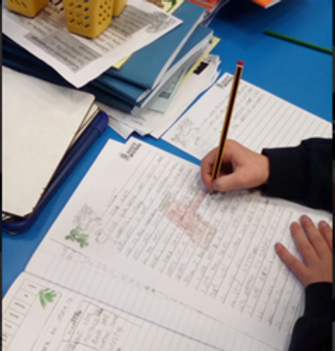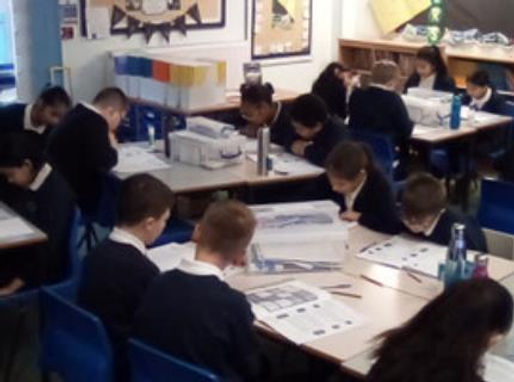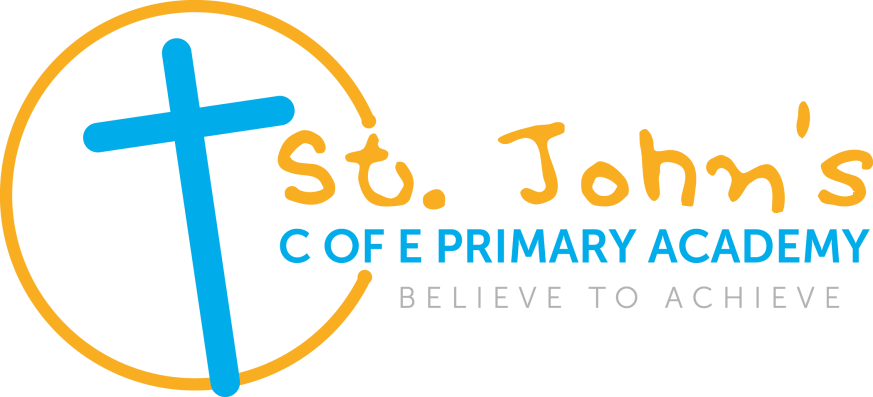English

For phonics, please see the separate phonics page.
Intent
At St John’s CE Primary Academy, English and the teaching of English, is the foundation of our curriculum.
Our main aim is to ensure every single child is on track to becoming primary literate by the end of Year 6 and makes good progress in the areas of reading, writing, speaking and listening.
When children leave St John’s CE Primary Academy, we expect them to be developing into avid readers, who read fluently and widely and are able to express preferences and opinions about the texts that they read. We want them to read for pleasure, having had access to a wide range of text types, genres and authors in order for them to make informed opinions about their favourites.
We want to produce children who write with confidence and accuracy for a variety of purposes and audiences, whilst developing their own individual flair. We want our children to be able to write with grammatical accuracy and be able to apply spelling patterns correctly using a neat, legible handwriting style.
We aim to expose our children to a wide range of vocabulary so that they are able to decipher new words and then use them when speaking both informally and formally.
English at St John’s CE Primary Academy will not only be a daily discrete lesson, but is at the cornerstone of the entire curriculum. When the new curriculum was implemented in 2014, many professionals commented that the creativity had been eliminated and children were expected to be taught a diet of very dry grammar and punctuation skills. At St John’s CE Primary Academy, our vision is for creativity to be at the helm of our English curriculum stemmed from our carefully selected topics and for children to learn new skills in a fun, engaging and purposeful way.

Implementation
Early Reading and Writing Skills
At St John’s CE Primary Academy, early reading is led by Little Wandle. It's complete SSP has been built around the update (Letters and Sounds improving rates of progress 2021). Little Wandle Letters and Sounds Revised also draws on the latest research into how children learn best; how to ensure learning stays in children’s long term memory and how best to enable children to apply their learning to become highly competent readers.
Regular training and development days ensure that staff are equipped to teach with the expertise and skills required to promote excellent progress, as well as a love of reading.
Early writing is taught through early mark making, then they are taught the correct letter formations. This begins with writing (whether with a writing tool or in the air) CVC words, moving onto short sentences using the sounds they have been taught. EYFS children are encouraged to write independently during continuous provision. We use the same phonics program across the school providing continuity and a vehicle for guaranteed progression.
English Lesson Sequence
Each year group has a yearly overview of the genres, both narrative and non-fiction, that they will teach. These have been planned to ensure correct coverage of the key genres as well as build on skills from year to year. Units will take between one and two weeks to complete, and the outcome of each unit will be an extended piece of writing which will be used to assess the pupil’s skills against the agreed success criteria. Every unit is linked where possible to the classes overarching topic, and/or a high quality, language rich text that acts as a stimulus for teaching the identified text, word and sentence level features that children will be expected to include (via existing knowledge or up-levelling using PPP [Purple Pen of Power]) in their extended writing outcome for that unit.
Key Stage 1
L1 - Genre features > L2-4 - SPaG features > L5 - Hot Write
Where appropriate, writing sequences in Key Stage 1, may mirror Key Stage 2.
Key Stage 2
L1 - Genre features > L2 - SPaG features > L3-7 - Series of SPaG skills implemented > L8-9 Hot Write
Classroom organisation
We teach English as whole class lessons, so that all children have access to the age-related skills and knowledge contained in the National Curriculum. Within lessons, teachers and LSPs target support to enable all children to achieve at an age-related level wherever possible. This may involve a greater level of scaffolding and access to additional support materials or a greater level of modelling for some children. Higher attaining children are given opportunities to extend their writing in a variety of ways, including through showing greater control in their writing, a deeper understanding of the impact that their writing has on the reader and by using a higher level of vocabulary and grammatical features.
Spellings
Once the Phonics scheme is completed or alongside from Year 1, children are taught the spelling rules and words contained in Appendix 1 of the English National Curriculum, through the St. John’s Spelling Scheme scheme. This happens from Year 1 onwards.
Spellings are sent home to practise weekly in Key Stage 2. The spellings for the year are in the attached documents at the foot of the page.
Grammar and Punctuation
Grammar and punctuation knowledge and skills are taught as much as possible by linking them to the genre being taught to make them more connected with the intended writing outcome. Teachers sometimes focus on particular grammar and punctuation skills as stand-alone lessons; if they feel that the class need additional lessons to embed and develop their understanding or to consolidate skills.
Handwriting
Handwriting is taught weekly through a scheme called letterjoin, beginning in reception through to year 6. They begin with print, and make there way all the way through to cursive handwriting. Children are then encouraged to apply what they learn in handwriting sessions to their work across the curriculum.
Assessment
Teachers assess Reading and Writing against a set framework, which has been produced in line with the end of Key Stage assessment frameworks as published by the Department for Education, as well as exemplar moderation materials from Sandwell LA and St. Chads Academies Trust. It is expected that teachers will moderate as a whole school, across year groups and with other local schools in time for data drops throughout the year.
Class texts
Every class has a high quality text that is read to them on a daily basis linked to their learning on Literacy Shed.
In class reading
All children are heard read at least once a week by their class teacher or support staff. Twice a week children are able to visit a classroom of their choosing to hear a 'reading for pleasure book' being read by a class teacher.
Home Reading
Our whole library has recently seen a huge overhaul, with £1000’s spent on it. At St John’s CE Primary Academy, children take home two books at a time, one Big Cat Collins. book linked with the phonic patterns that they are currently learning, and one ‘real life’ book written by quality author that has been carefully matched to each of the levels on the Big Cat Reading scheme. At St John’s CE Primary Academy, we have recently invested in Reading Eggs which also offers a plethora of E-Books too. Children who are not on banded books are able to access our free readers sections which are closely monitored by staff to ensure challenge and appropriateness.
Whole school events
Throughout the school year, the importance of reading and writing is enhanced through World Book Day, author and poet visits, parent workshops and a range of trips and visits which enrich and complement the children’s learning. We also plan whole school competitions such as ‘Extreme Reading’ photo competitions and other writing competitions that bring the whole school together to concentrate on one theme.
Parent Engagement
We run parent information sessions on phonics for Year 1 parents, reading and SATs for Year 2 and Year 6 parents so that they understand age-related expectations. These sessions are always very well attended by parents and carers who often comment about how helpful the sessions have been for them. We also host Parent Drop In sessions, where parents join their children in their English lesson.

Impact
What is the impact?
The impact of these measures can be evidenced in the following ways:
Pupil voice
Through discussion and feedback, children talk enthusiastically about reading and writing and understand the importance of English as a subject. They also talk about books and authors that they have enjoyed and can make reading recommendations. They enjoy writing and use the features of different genres, confidently writing for different purposes and audiences.
Evidence in knowledge
Children make links between texts and the different themes and genres within them. They recognise similarities and differences between texts. Children understand the reading and writing process.
Evidence in skills
Children are taught reading and writing progressively and at a pace appropriate to each individual child. Teachers’ subject knowledge ensures that skills taught are matched to National Curriculum objectives. As all aspects of English are an integral part of the curriculum, cross curricular writing standards have improved and skills taught in the daily English lesson are transferred into other subjects. This shows consolidation of skills and a deeper understanding of how and when to use specific grammar, punctuation and grammar objectives.
Evidence in books
Every term, teachers moderate children’s work in school and cluster meetings with other schools ensure accurate assessments are made. The quality of writing in English and in other areas of the curriculum is evaluated by learning walks, lesson drop-ins and book looks. These inform future areas for improvement and the impact of new initiatives. The English subject leader provides an action plan for the subject and addresses areas for development and improvement which is then shared with all staff.
Outcomes
At the end of each year we expect the children to have achieved Age Related Expectations (ARE) for their year group. Some children will have progressed further and achieved greater depth standard (GDS). Children who have gaps in their knowledge receive appropriate support and intervention.
